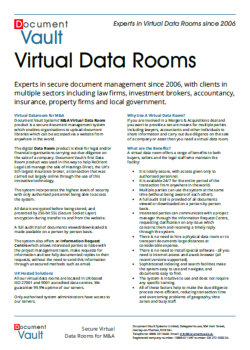Document Vault Blog
Document Vault is most frequently used for managing mergers & acquisitions deals, with all the information stored online in a secure "vault". Access is first given to the lawyers and financial advisors on the Sellers side, who upload the document repository to the vault.
The documents are typically structured in a numbered, hierarchical system which makes browsing through the documents easy. Of course, the documents are indexed during upload so that full text search is also possible.
When ready, the Data Room Administrator will invite the individuals on the Buyers side to log into the data room and access the documents. Whereas, users on the Sellers side will typically have the ability to read and upload documents, the Buyers side will only have read-only access. The Sellers team can either release all the documents to be viewed in one go or release them in stages, thus giving better control over the disclosure process.
A full audit trail of what individual users have accessed is available for administrators and project managers to view, letting them know exactly which documents have been looked at, and conversely which have not.
Whilst Document Vault utilises complex technology to ensure the integrity of the data and give secure access to the documents, the system is easy to use and configure. Its permission-based controls over document access are easily applied, ensuring that only authorised users have access to the documents concerned.
At the end of the transaction, the data room will be "locked" for upload, meaning that the copy of the data in the vault is the final version. A copy of the data is then saved from the data room and added to an encrypted USB drive or DVD, which is then sent by Special Delivery (tracked and signed for) to the designated individuals on the Selling and Buying side. On receipt, an encryption key is sent to unlock the data. Before sending, a full check of the data integrity is made to ensure that all documents are present and accessible from the data drive.
The disclosure process can then be followed to its natural conclusion with the sale of business or asset concerned.
See also:
Request Further Information
Click below to request more information about our virtual data rooms or call Freephone 0808 221 0440 to speak to a member of our team.







Leave a comment